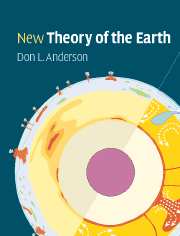Book contents
- Frontmatter
- Contents
- Preface and Philosophy
- Abbreviations and acronyms
- Part I Planetary perspective
- Part II Earth: the dynamic planet
- Chapter 4 The outer shells of Earth
- Chapter 5 The eclogite engine
- Chapter 6 The shape of the Earth
- Chapter 7 Convection and complexity
- Part III Radial and lateral structure
- Part IV Sampling the Earth
- Part V Mineral physics
- Part VI Origin and evolution of the layers and blobs
- Part VII Energetics
- References and notes
- Appendix
- Index
Chapter 4 - The outer shells of Earth
Published online by Cambridge University Press: 05 June 2012
- Frontmatter
- Contents
- Preface and Philosophy
- Abbreviations and acronyms
- Part I Planetary perspective
- Part II Earth: the dynamic planet
- Chapter 4 The outer shells of Earth
- Chapter 5 The eclogite engine
- Chapter 6 The shape of the Earth
- Chapter 7 Convection and complexity
- Part III Radial and lateral structure
- Part IV Sampling the Earth
- Part V Mineral physics
- Part VI Origin and evolution of the layers and blobs
- Part VII Energetics
- References and notes
- Appendix
- Index
Summary
When I use a word, it means just what I choose it to mean – neither more nor less.
The question is, whether you CAN make words mean so many different things.
The question is, which is to be master – that's all.
Humpty Dumpty and AlicePlate tectonics involves the concepts of plates, lithospheres, cratonic keels and thermal boundary layers; these are not equivalent concepts. Lithosphere means rocky shell or strong layer. It can support significant geologic loads, such as mountains, and can bend, as at trenches, without significant time-dependent deformation; it behaves elastically. Plates are not necessarily strong or elastic. Thermal boundary layers conduct heat out of the underlying regions; they are defined by a particular thermal gradient.
Plates
A plate is a region of the Earth's surface that translates coherently. The word plate as in plate tectonics implies strength, brittleness and permanence and often the adjectives rigid and elastic are appended to it. But plates are collages, held together by stress and adjacent portions rather than by intrinsic strength. Plates break at suture zones (former plate boundaries), fracture zones and subplate boundaries, often generating volcanic chains in the process. A plate can be rigid in the sense that relative plate motions can be described by rotations about Euler poles on a sphere but can still have meter-wide cracks, which is all that is needed to create volcanic chains from the hot underlying mantle and its low-viscosity magmas.
- Type
- Chapter
- Information
- New Theory of the Earth , pp. 35 - 57Publisher: Cambridge University PressPrint publication year: 2007



